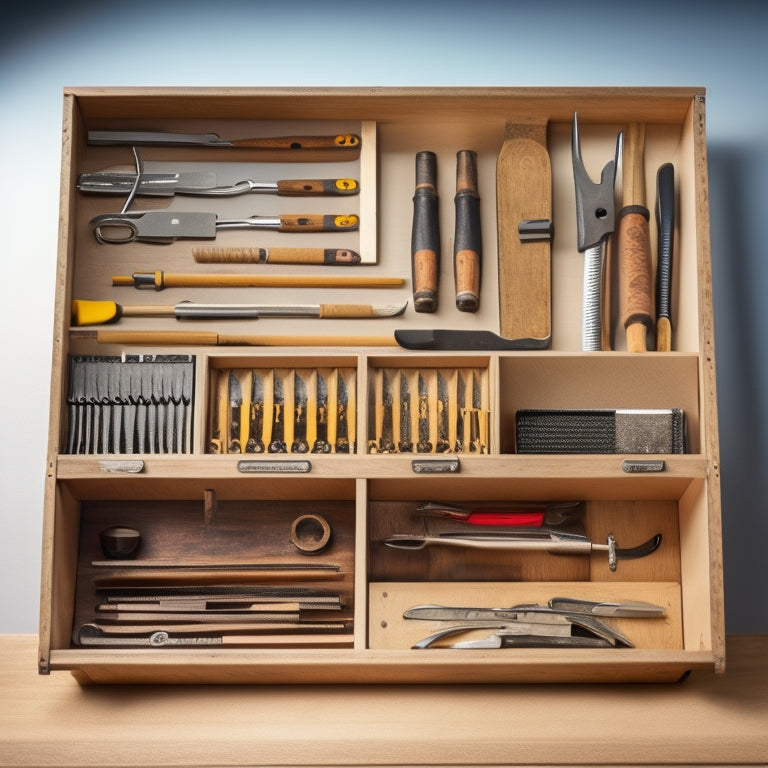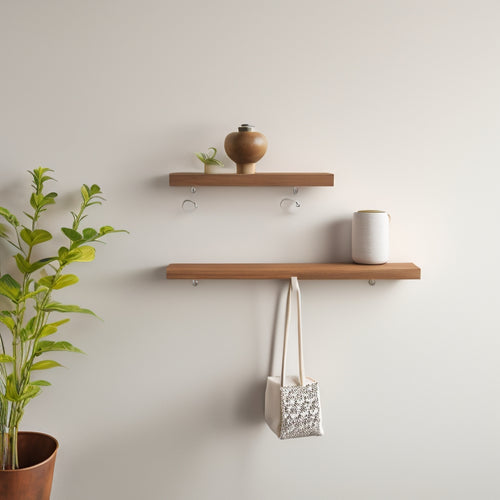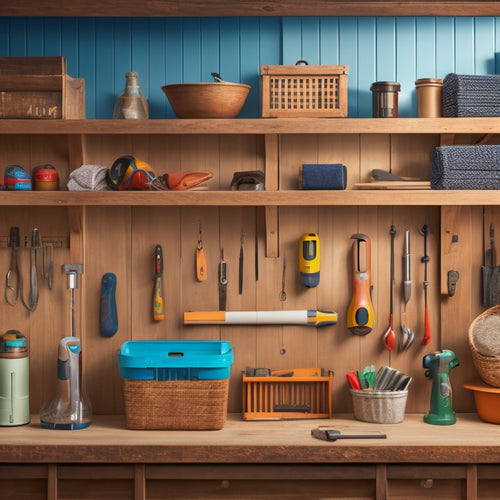
Hand Tool Box Essentials for Home and Workshop
Share
You're likely no stranger to DIY project frustrations caused by a lack of vital hand tools. Building a well-stocked hand tool box is essential for efficiency and success. Start with basics like a quality hammer, tape measure, level, and utility knife. Add a mix of pliers, including slip-joint, needle-nose, and locking pliers, and don't forget cutting tools like rotary tools and snips. Measuring and marking tools, fastening and joining tools, and hand saws for woodworking are also must-haves. With these essentials on hand, you'll be well-equipped to tackle any project - and there's even more to investigate to take your DIY game to the next level.
Key Takeaways
- A quality hammer, tape measure, level, and utility knife form the foundation of a DIY toolkit for home and workshop.
- A mix of plier types, including slip-joint, needle-nose, and locking pliers, is necessary for gripping and twisting objects.
- Accurate measuring and marking tools, such as reliable tape measures and marking gauges, are vital for project success.
- A variety of fastening and joining tools, including screwdrivers, clamps, and hammers, is essential for secure holds in projects.
- A well-organized toolbox with designated spots for each tool improves workspace efficiency, reduces clutter, and enhances safety.
Basic Hand Tools for DIYers
As a DIYer, a well-stocked hand tool box is your best friend, and it all starts with the basics. You'll need a solid foundation of essential hand tools to tackle any project that comes your way. Beginner toolkits often include the most important tools, but it's vital to understand what makes them essential.
Invest in a good quality hammer with a comfortable grip and balanced weight. A tape measure is another must-have, guaranteeing accurate measurements every time. You'll also need a level to make certain your projects are straight and level. A utility knife with interchangeable blades is perfect for cutting various materials.
Don't forget a set of screwdrivers with essential tool features like ergonomic handles and precision tips. These basic hand tools will help you complete tasks safely and efficiently.
Always choose tools with durable materials and ergonomic design to reduce fatigue and prevent injuries. Remember, a well-stocked hand tool box is key to your success as a DIYer, and it's worth investing in high-quality tools that will last for years to come.
Pliers and Grip Essentials
At least a dozen pliers and grip essentials should be in your hand tool box to confirm you're prepared for various tasks. Having the right pliers can make all the difference in achieving a solid grip and getting the job done efficiently.
You'll need a mix of plier types, including slip-joint, needle-nose, and locking pliers, to tackle different tasks. Slip-joint pliers are ideal for gripping and twisting objects, while needle-nose pliers are perfect for reaching into tight spaces. Locking pliers, on the other hand, provide extra grip strength and are great for holding objects in place.
Don't forget to include grip essentials like wire grips, bolt grips, and tubing grips to confirm you're equipped for any situation.
When choosing pliers, consider the material, size, and ergonomics. Look for pliers with comfortable grips and rust-resistant coatings to confirm they last long and perform well.
With a well-stocked plier and grip collection, you'll be able to tackle a wide range of tasks with confidence and achieve professional-looking results.
Cutting Tools for Every Task
Your toolbox isn't complete without a versatile set of cutting tools to tackle various tasks. From rough cutting to precision trimming, having the right cutting tools guarantees you're prepared for any project.
Here are three essential cutting tools to include in your collection:
-
Utility knives: For general-purpose cutting, utility knives are a must-have. They're perfect for cutting drywall, carpet, or roofing materials.
-
Rotary tools: With interchangeable bits, rotary tools offer versatility for cutting, grinding, and polishing. They're ideal for precision work, like cutting metal pipes or shaping wood.
-
Snips and shears: For cutting thin materials like wire, metal sheets, or plastic, snips and shears are the way to go. They're also great for trimming craft projects or cutting through thick fabric.
In addition to these essentials, consider adding precision cutters, chisel sets, wire cutters, craft knives, and box cutters to your collection.
Remember to always handle cutting tools with care and follow safety guidelines to avoid accidents. With these cutting tools, you'll be well-equipped to tackle any task that comes your way.
Measuring and Marking Tools
When you're working on a project, accuracy is key, and that's where your measuring and marking tools come in.
You'll be using these tools constantly to guarantee everything is straight, level, and properly sized. From tape measures to levels and marking gauges, these essentials help you get the job done right.
Tape Measures Matter
From the get-go, a reliable tape measure is an indispensable companion in your hand tool box, serving as the backbone of your measuring and marking arsenal. You can't afford to compromise on accuracy and durability when it comes to measuring and marking tasks.
When choosing a tape measure, you'll come across various tape types, each suited for specific applications. Consider the following key factors:
-
Measurement accuracy: Look for tapes with clear, easy-to-read markings and a high level of precision.
-
Tape durability: A rugged tape with a durable coating can withstand harsh job site conditions.
-
Retractable features: A smooth, consistent retraction mechanism guarantees the tape glides effortlessly back into its housing, reducing the risk of damage or injury.
Additionally, consider tape storage and width, as well as its applications in layout planning.
With a quality tape measure in your hand tool box, you'll be well-equipped to tackle a wide range of projects, from simple DIY tasks to complex construction jobs.
Level It Up
Precision takes center stage when it comes to measuring and marking tools, and a reliable level is the unsung hero of the hand tool box. You can't afford to skimp on accuracy, especially when working on projects that require perfect alignment. A good level guarantees your shelves, cabinets, and floors are perfectly horizontal and vertical, saving you from costly mistakes and potential safety hazards.
When choosing a level, consider upgrading to a high-precision model with a certification from a recognized standards organization. These tools provide accurate readings even in harsh environments. For added convenience, look for levels with adjustable vials, magnetic edges, or LED lights that illuminate the work surface.
To keep your level in top condition, regularly clean the vials and edges, and store it in a protective case when not in use. Check the level's accuracy periodically by comparing its readings to a known reference point.
Marking Gauges Rule
Your marking gauge is the ultimate precision instrument for making accurate markings on your workpieces. With this versatile tool, you can achieve precise markings, ensuring your projects turn out exactly as planned. A marking gauge is essential for various marking techniques, including mortise and tenon joints, dados, and rabbets.
There are different gauge types to suit your specific needs:
-
Standard marking gauge: Ideal for general-purpose marking, this gauge features a fixed fence and a moveable pin.
-
Mortise gauge: Designed for precise mortise and tenon joints, this gauge has two pins spaced at a fixed distance.
-
Bevel gauge: This gauge allows for adjustable angles, making it perfect for marking bevels and compound angles.
When choosing a marking gauge, consider the type of projects you'll be working on and the level of precision required.
Always follow safety guidelines when using your marking gauge, ensuring your workpieces are securely held in place and your hands are kept away from the sharp pins.
With a marking gauge in your hand tool box, you'll be able to create accurate markings with ease and confidence.
Fastening and Joining Tools
You'll rely on fastening and joining tools to hold things together, literally. These tools are indispensable for any project, from assembling furniture to building a deck.
You'll need a variety of screwdrivers, including flathead, Phillips, and hex (or Allen) drivers, to tackle different screw types. Invest in a set that includes both manual and powered drivers for versatility.
Mastering fastening techniques is essential for a secure hold. Learn how to drive screws at the correct angle, use the right amount of torque, and avoid stripping or over-tightening.
Clamps are also important for holding pieces together while you fasten or glue them. Bar clamps, C-clamps, and spring clamps will cover most of your needs.
Don't forget about other joining tools like hammers, tape measures, and levels. A hammer is necessary for tapping pieces into place, while a tape measure and level guarantee accuracy and precision.
With these fastening and joining tools in your box, you'll be well-equipped to tackle a wide range of projects safely and effectively.
Hand Saws for Woodworking
The hand saws in your woodworking arsenal will make precise cuts, allowing you to shape and craft wood with confidence.
With the right hand saw types, you'll be able to tackle various woodworking projects efficiently and safely.
When choosing hand saws, consider the following vital types:
-
Rip saw: For cutting with the wood grain, ideal for ripping boards and planks.
-
Crosscut saw: For cutting across the wood grain, perfect for cutting boards to specific lengths.
-
Dovetail saw: For precise, intricate cuts, often used for joinery and fine woodworking.
Proper saw maintenance is essential for peak performance and safety.
Regularly inspect your saws for dull or damaged blades, and sharpen or replace them as needed.
Clean and store your saws in a dry place to prevent rust and corrosion.
Toolbox Organization Tips
You've invested in a solid set of hand tools, but now it's time to get them organized. A well-organized toolbox saves you time and frustration, and starts with a few key strategies: arranging your tools in a logical way, assigning a home for each item, and labeling and signing everything so you can find what you need at a glance.
Tool Arrangement Strategies
About twenty tools in your hand tool box are used eighty percent of the time. This means that a well-organized toolbox can greatly improve your workspace efficiency.
To maximize your tool storage, consider the following tool arrangement strategies:
-
Group similar tools together: Store tools of the same category, such as pliers, wrenches, or screwdrivers, in the same compartment or section. This allows you to quickly find the tool you need when you need it.
-
Prioritize frequently used tools: Place your most frequently used tools in easy-to-reach locations, making it simple to grab them when you're in the middle of a project.
-
Designate a specific place for each tool: Assign a specific spot for each tool, ensuring that everything has a designated home. This prevents tools from getting lost or misplaced, reducing the risk of accidents and injuries.
Assign a Home
Now that you've optimized your tool arrangement strategies, it's time to get specific about assigning a home for each tool. This is essential for efficient tool storage and a well-organized workspace layout. By designating a specific spot for each tool, you'll avoid clutter, reduce the risk of lost or damaged tools, and save time searching for what you need.
| Tool Category | Storage Location | Why It Works |
|---|---|---|
| Hand tools | Top tray or easy-access compartment | Frequently used tools are within easy reach |
| Power tools | Designated power tool compartment | Keep cords and accessories organized |
| Fasteners and fixings | Small parts organizer or drawer | Easily find what you need, even in small quantities |
Assigning a home for each tool also helps maintain a safe workspace. By keeping tools in their designated spots, you'll avoid tripping hazards, reduce the risk of accidents, and guarantee that your workspace remains tidy and organized.
Label and Sign
With your tools assigned to their designated homes, it's time to take your toolbox organization to the next level by labeling and signing each storage location. This step is essential in guaranteeing you can quickly find what you need, reducing frustration and increasing productivity.
When it comes to labeling techniques, you'll want to take into account the following:
-
Clear and concise labels: Use a bold, easy-to-read font to identify the contents of each storage space. Avoid using abbreviations or acronyms that might confuse you or others.
-
Color-coding: Use different colors to categorize your tools, such as red for power tools, blue for hand tools, and green for measuring instruments.
-
Icon-based labels: Incorporate simple icons or images to help you quickly identify the contents of each storage space, especially for those who are visually oriented.
In terms of sign design, keep it simple and easy to read. You can use a label maker or create your own signs using cardstock or vinyl stickers.
Remember to place signs at eye level to guarantee they're easily visible. By implementing these labeling techniques and sign design tips, you'll be able to maintain a well-organized toolbox that promotes safety and efficiency.
Specialty Tools for Specific Tasks
Tackle specific tasks with confidence by equipping your hand tool box with specialized tools designed for particular jobs.
You'll be amazed at how these tools can simplify complex tasks and guarantee accuracy. For instance, specialty hammers like a ball-peen hammer or a rubber mallet are perfect for precision tapping and shaping.
Precision screwdrivers with ergonomic handles provide better grip and control, reducing fatigue and slippage. Niche wrenches, such as a basin wrench or a faucet wrench, are designed for specific plumbing tasks, making it easier to access tight spaces.
Unique clamps like bar clamps or C-clamps hold materials firmly in place, guaranteeing accurate gluing and joining. Specialized chisels, like a diamond-point chisel or a flat chisel, are ideal for removing mortar or breaking up concrete.
Custom jigs and tool accessories, such as a marking gauge or a combination square, help you make precise measurements and cuts.
Frequently Asked Questions
What Is the Best Way to Clean and Maintain Hand Tools?
When cleaning hand tools, you'll prevent rust by wiping them dry and applying a rust-inhibiting spray. Store them in a dry, organized tool storage area, and regularly inspect for signs of wear to maintain their effectiveness and your safety.
Can I Use Hand Tools for Heavy-Duty Industrial Projects?
Oh, you think your trusty hand tool box is ready for heavy-duty industrial projects? Think again! Hand tool durability is key, but even industrial hand tools have limits - don't risk safety, use the right tools for the job, or you'll be crying 'Mayday!'
How Do I Choose the Right Tool for a Specific Task?
When choosing a tool, you'll want to contemplate the task at hand, literally! Follow tool selection tips to pick task-specific tools, ensuring you've got the right fit for the job, and prioritizing your safety in the process.
Are There Any Safety Precautions for Using Hand Tools?
When using hand tools, you'll want to prioritize tool usage safety to prevent injuries. Always wear protective gear, keep your workspace clean, and maintain tools in good condition to avoid accidents, and follow injury prevention tips like proper grip and stance.
Can I Use Hand Tools for Tasks Other Than Their Intended Purpose?
Don't think of your tools as one-trick ponies! You can creatively repurpose them for tasks beyond their intended purpose, showcasing tool versatility. However, always make sure you're not compromising safety or the tool's integrity in the process, and take necessary precautions to avoid accidents.
Conclusion
You've assembled a powerhouse of hand tools, and now your toolbox is a treasure chest overflowing with possibilities. Like a skilled chef with a well-stocked kitchen, you're ready to whip up anything from a simple repair to a complex project. With these essentials, you'll be equipped to tackle any task that comes your way, and your DIY skills will soar to new heights.
Related Posts
-

Adjustable Modular Shoe Racks for Versatility
Adjustable modular shoe racks are your go-to solution for versatile and organized footwear storage. These racks maxim...
-

Wall Mounted Hooks With Shelf for Maximum Storage
You'll find that wall mounted hooks with a shelf are a revolutionary solution for maximizing storage in your home, pr...
-

What Tools Do I Need for a DIY Wall Organizer
You'll need a variety of tools to complete a DIY wall organizer project. Essential measuring tools include a tape mea...


